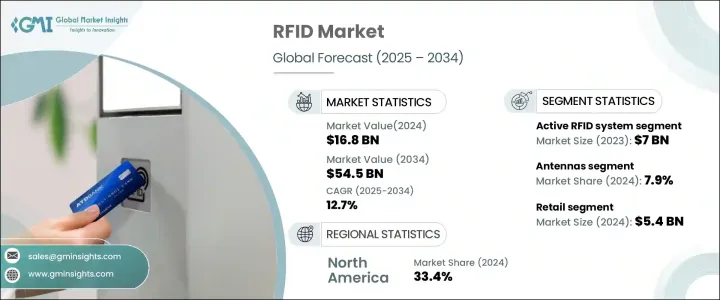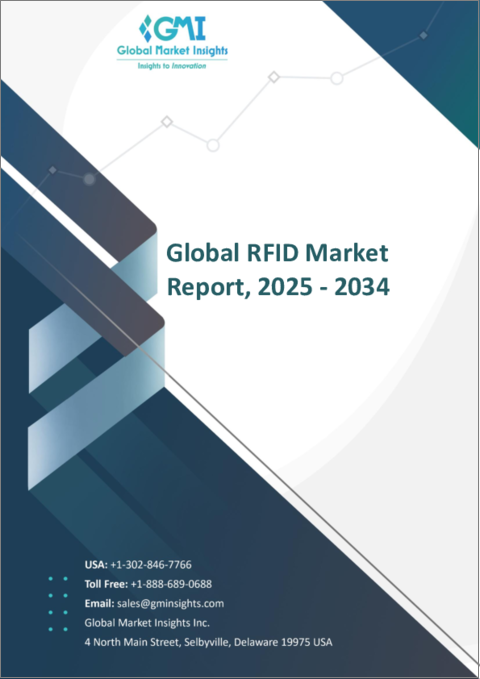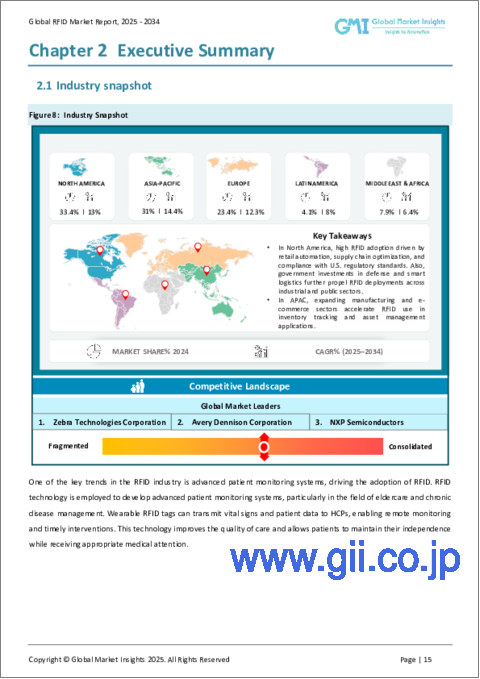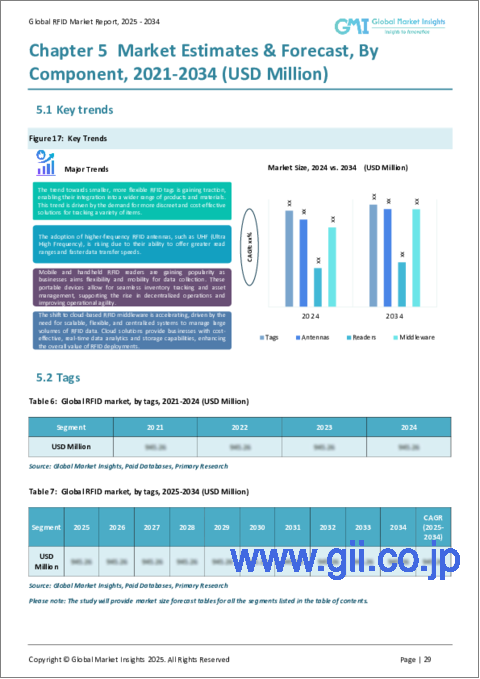|
|
市場調査レポート
商品コード
1698599
RFID市場の機会、成長促進要因、産業動向分析、2025年~2034年の予測RFID Market Opportunity, Growth Drivers, Industry Trend Analysis, and Forecast 2025-2034 |
||||||
カスタマイズ可能
|
|||||||
| RFID市場の機会、成長促進要因、産業動向分析、2025年~2034年の予測 |
|
出版日: 2025年02月14日
発行: Global Market Insights Inc.
ページ情報: 英文 190 Pages
納期: 2~3営業日
|
全表示
- 概要
- 目次
世界のRFID市場は2024年に168億米ドルに達し、2025年から2034年にかけて12.7%のCAGRで成長すると予測されています。
この成長は、リアルタイムのサプライチェーン可視性、業務の透明性に対する需要の高まり、ヘルスケアや医薬品分野でのRFID技術の採用拡大に起因しています。企業は、自動在庫追跡、ヒューマンエラーの最小化、ロジスティクス効率の向上のためにRFIDを活用するようになってきています。この技術により、企業は最適な在庫レベルを維持し、在庫不足を防ぎ、過剰在庫を減らすことができます。RFIDの採用はまた、サプライチェーン業務の合理化による大幅なコスト削減にもつながります。

ヘルスケア分野では、RFIDは医薬品の在庫、有効期限、リコールのリアルタイム追跡を可能にすることで、投薬管理を強化します。自動化されたシステムは、ヘルスケア提供者に期限切れやリコールされた医薬品を警告し、患者の安全と業界規制へのコンプライアンスを確保します。さらに、RFID技術は在庫レベルを最適化し、無駄を削減し、サプライチェーンの混乱を防ぎます。この技術は医薬品分野でさらに進歩しており、ブロックチェーンとの統合によって医薬品のトレーサビリティが強化され、偽造が緩和され、規制遵守が確実になります。
| 市場範囲 | |
|---|---|
| 開始年 | 2024 |
| 予測年 | 2025-2034 |
| 開始金額 | 168億米ドル |
| 予測金額 | 545億米ドル |
| CAGR | 12.7% |
アクティブRFIDシステム市場は2023年に70億米ドルを突破し、タグ付きオブジェクトとアンテナ間のシームレスなデータ転送を促進する無線通信機能が牽引しています。これらのシステムは、サプライチェーン・モニタリング、資産追跡、セキュリティ・アクセス制御、家畜管理などで幅広く利用されています。一方、パッシブRFIDシステム市場は2022年に74億米ドルと評価されました。パッシブRFIDタグは電源なしで動作し、RFIDリーダーから受け取るエネルギーに依存します。これらのタグは、小売店の在庫追跡、POS取引、倉庫管理などのアプリケーションを効率的にサポートします。
市場は、RFIDタグ、アンテナ、リーダー、ミドルウェアなどのコンポーネント別に区分されます。RFIDタグは2024年の市場シェアの41.4%以上を占め、在庫管理や資産監視など多様な用途に対応しています。無線信号の送受信に重要な役割を果たすアンテナは、市場シェアの7.9%以上を占めています。RFIDリーダーは、タグと企業システム間のシームレスなデータ交換を可能にし、売上シェアの16.7%に貢献しました。RFIDシステムをビジネスアプリケーションと統合するソフトウェアで構成されるミドルウェアは、市場シェアの約34%を占めています。
RFIDのアプリケーションは、小売、金融サービス、ヘルスケア、産業、政府部門に及んでいます。2024年に54億米ドルを超えると評価される小売市場は、リアルタイムの在庫に関する洞察を提供し、取引を合理化し、サプライチェーン・ロジスティクスを最適化するRFIDの能力から利益を得ています。金融サービスでは、RFIDは2023年に39億米ドルを突破し、業務効率を向上させながら、本人確認と盗難防止を通じてセキュリティを強化しました。ヘルスケア分野は2022年に28億米ドルに達し、RFIDは投薬追跡、患者監視、業務安全をサポートしています。産業セグメントは2023年に17億米ドルを占め、資産追跡のためのRFIDの政府採用は2024年に11億米ドルの市場規模に貢献しました。
地域別では、北米が2024年の世界RFID市場の33.4%以上を占め、米国だけで39億米ドルの売上がありました。ID管理、ロジスティクス、セキュリティー用途でのRFID利用の増加が、この地域の市場拡大を後押ししています。
目次
第1章 調査手法と調査範囲
- 市場範囲と定義
- 基本推定と計算
- 予測計算
- データソース
第2章 エグゼクティブサマリー
第3章 業界洞察
- エコシステム分析
- バリューチェーンに影響を与える要因
- 利益率分析
- ディスラプション
- 将来の展望
- メーカー
- 流通業者
- サプライヤーの状況
- 利益率分析
- 主要ニュース
- 規制状況
- 影響要因
- 促進要因
- サプライチェーンの可視性と透明性に対する需要の高まり
- ヘルスケアと医薬品分野の拡大
- IoTおよびインダストリー4.0との統合
- スマートインフラに対する政府の取り組み
- 業界の潜在的リスク&課題
- 高い初期導入コスト
- データ・セキュリティとプライバシーに関する懸念
- 促進要因
- 成長可能性分析
- ポーター分析
- PESTEL分析
第4章 競合情勢
- イントロダクション
- 企業シェア分析
- 競合のポジショニング・マトリックス
- 戦略展望マトリックス
第5章 市場推計・予測:コンポーネント別、2021年~2034年
- 主要動向
- タグ
- アンテナ
- リーダー
- ミドルウェア
第6章 市場推計・予測:システム別、2021年~2034年
- 主要動向
- アクティブRFIDシステム
- パッシブRFIDシステム
第7章 市場推計・予測:用途別、2021年~2034年
- 主要動向
- 小売
- 金融サービス
- ヘルスケア
- 産業
- 政府機関
- その他
第8章 市場推計・予測:地域別、2021年~2034年
- 主要動向
- 北米
- 米国
- カナダ
- 欧州
- 英国
- ドイツ
- フランス
- イタリア
- スペイン
- ロシア
- アジア太平洋
- 中国
- インド
- 日本
- 韓国
- オーストラリア
- ラテンアメリカ
- ブラジル
- メキシコ
- 中東・アフリカ
- 南アフリカ
- サウジアラビア
- アラブ首長国連邦
第9章 企業プロファイル
- 3M Company
- Alien Technology
- Avery Dennison Corporation
- CAEN RFID
- Checkpoint Systems
- Datalogic S.p.A.
- HID Global Corporation
- Impinj, Inc.
- Invengo Technology Pte. Ltd.
- Mojix, Inc.
- NXP Semiconductors
- Smartrac N.V.
- STMicroelectronics
- Sato Holdings Corporation
- Zebra Technologies Corporation
The Global RFID Market reached USD 16.8 billion in 2024 and is projected to grow at a CAGR of 12.7% from 2025 to 2034. This growth stems from rising demand for real-time supply chain visibility, operational transparency, and the expanding adoption of RFID technology across healthcare and pharmaceuticals. Businesses are increasingly leveraging RFID for automated inventory tracking, minimizing human errors, and improving logistics efficiency. The technology enables organizations to maintain optimal stock levels, prevent inventory shortages, and reduce overstocking. RFID adoption also leads to significant cost reductions by streamlining supply chain operations.

In the healthcare sector, RFID enhances medication management by enabling real-time tracking of drug inventory, expiration dates, and recalls. Automated systems alert healthcare providers to expired or recalled medications, ensuring patient safety and compliance with industry regulations. Additionally, RFID technology optimizes stock levels, reduces waste, and prevents supply chain disruptions. The technology is further advancing in pharmaceuticals, where integration with blockchain enhances drug traceability, mitigates counterfeiting, and ensures regulatory compliance.
| Market Scope | |
|---|---|
| Start Year | 2024 |
| Forecast Year | 2025-2034 |
| Start Value | $16.8 Billion |
| Forecast Value | $54.5 Billion |
| CAGR | 12.7% |
The active RFID system market surpassed USD 7 billion in 2023, driven by wireless communication capabilities that facilitate seamless data transfer between tagged objects and antennas. These systems find extensive use in supply chain monitoring, asset tracking, security access control, and livestock management. Meanwhile, the passive RFID system market was valued at USD 7.4 billion in 2022. Passive RFID tags operate without a power source, relying on energy received from RFID readers. These tags efficiently support applications such as retail inventory tracking, point-of-sale transactions, and warehouse management.
The market is segmented by components, including RFID tags, antennas, readers, and middleware. RFID tags accounted for over 41.4% of the market share in 2024, serving diverse applications in inventory control and asset monitoring. Antennas, which play a key role in transmitting and receiving radio signals, captured more than 7.9% of the market share. RFID readers contributed to 16.7% of the revenue share, enabling seamless data exchange between tags and enterprise systems. Middleware, comprising software that integrates RFID systems with business applications, held about 34% of the market share.
RFID applications span retail, financial services, healthcare, industrial, and government sectors. The retail market, valued at over USD 5.4 billion in 2024, benefits from RFID's ability to provide real-time inventory insights, streamline transactions, and optimize supply chain logistics. In financial services, RFID surpassed USD 3.9 billion in 2023, enhancing security through identity verification and theft protection while improving operational efficiency. The healthcare sector reached USD 2.8 billion in 2022, with RFID supporting medication tracking, patient monitoring, and operational safety. The industrial segment accounted for USD 1.7 billion in 2023, and government adoption of RFID for asset tracking contributed to a USD 1.1 billion market size in 2024.
Regionally, North America represented over 33.4% of the global RFID market in 2024, with the U.S. alone generating USD 3.9 billion in revenue. Increased use of RFID in identity management, logistics, and security applications is propelling regional market expansion.
Table of Contents
Chapter 1 Methodology & Scope
- 1.1 Market scope & definitions
- 1.2 Base estimates & calculations
- 1.3 Forecast calculations
- 1.4 Data sources
- 1.4.1 Primary
- 1.4.2 Secondary
- 1.4.2.1 Paid sources
- 1.4.2.2 Public sources
Chapter 2 Executive Summary
- 2.1 Industry synopsis, 2021-2034
Chapter 3 Industry Insights
- 3.1 Industry ecosystem analysis
- 3.1.1 Factor affecting the value chain
- 3.1.2 Profit margin analysis
- 3.1.3 Disruptions
- 3.1.4 Future outlook
- 3.1.5 Manufacturers
- 3.1.6 Distributors
- 3.2 Supplier landscape
- 3.3 Profit margin analysis
- 3.4 Key news & initiatives
- 3.5 Regulatory landscape
- 3.6 Impact forces
- 3.6.1 Growth drivers
- 3.6.1.1 Increasing demand of supply chain visibility and transparency
- 3.6.1.2 Expansion in healthcare & pharmaceuticals
- 3.6.1.3 Integration with IoT & industry 4.0
- 3.6.1.4 Government initiatives for smart infrastructure
- 3.6.2 Industry pitfalls & challenges
- 3.6.2.1 High initial implementation costs
- 3.6.2.2 Data security & privacy concerns
- 3.6.1 Growth drivers
- 3.7 Growth potential analysis
- 3.8 Porter's analysis
- 3.9 PESTEL analysis
Chapter 4 Competitive Landscape, 2024
- 4.1 Introduction
- 4.2 Company market share analysis
- 4.3 Competitive positioning matrix
- 4.4 Strategic outlook matrix
Chapter 5 Market Estimates & Forecast, By Component, 2021-2034 (USD Million)
- 5.1 Key trends
- 5.2 Tags
- 5.3 Antennas
- 5.4 Readers
- 5.5 Middleware
Chapter 6 Market Estimates & Forecast, By System, 2021-2034 (USD Million)
- 6.1 Key trends
- 6.2 Active RFID system
- 6.3 Passive RFID system
Chapter 7 Market Estimates & Forecast, By Application, 2021-2034 (USD Million)
- 7.1 Key trends
- 7.2 Retail
- 7.3 Financial services
- 7.4 Healthcare
- 7.5 Industrial
- 7.6 Government
- 7.7 Others
Chapter 8 Market Estimates & Forecast, By Region, 2021-2034 (USD Million)
- 8.1 Key trends
- 8.2 North America
- 8.2.1 U.S.
- 8.2.2 Canada
- 8.3 Europe
- 8.3.1 UK
- 8.3.2 Germany
- 8.3.3 France
- 8.3.4 Italy
- 8.3.5 Spain
- 8.3.6 Russia
- 8.4 Asia Pacific
- 8.4.1 China
- 8.4.2 India
- 8.4.3 Japan
- 8.4.4 South Korea
- 8.4.5 Australia
- 8.5 Latin America
- 8.5.1 Brazil
- 8.5.2 Mexico
- 8.6 MEA
- 8.6.1 South Africa
- 8.6.2 Saudi Arabia
- 8.6.3 UAE
Chapter 9 Company Profiles
- 9.1 3M Company
- 9.2 Alien Technology
- 9.3 Avery Dennison Corporation
- 9.4 CAEN RFID
- 9.5 Checkpoint Systems
- 9.6 Datalogic S.p.A.
- 9.7 HID Global Corporation
- 9.8 Impinj, Inc.
- 9.9 Invengo Technology Pte. Ltd.
- 9.10 Mojix, Inc.
- 9.11 NXP Semiconductors
- 9.12 Smartrac N.V.
- 9.13 STMicroelectronics
- 9.14 Sato Holdings Corporation
- 9.15 Zebra Technologies Corporation






